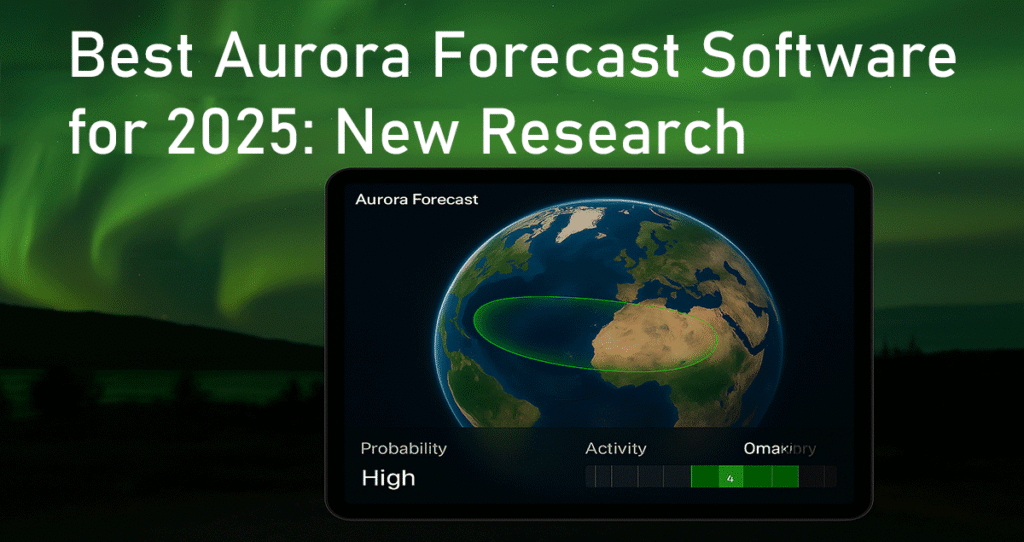Experiencing the aurora borealis is one of nature’s top sights on Earth, and 2025 sees the most advanced prediction tools available, easing planning to see these displays. New aurora forecasts rely on satellites, monitoring of the sun, and machine intelligence, which helps provide very accurate predictions for seeing the northern lights.
Now, technology meant for research institutions is within the reach of Aurora fans. To know when and where to see the aurora, these platforms observe solar wind, geomagnetism, and air conditions. People of all levels of interest in astronomy can make use of advanced forecasting tools.
The revolution in northern lights forecasting represents decades of scientific advancement compressed into user-friendly applications. Advanced algorithms process real-time data from multiple satellites, ground-based sensors, and solar observatories to generate precise predictions spanning from immediate 30-minute updates to comprehensive monthly outlooks. This technological leap has fundamentally changed aurora watching from guesswork into strategic planning.
The Science Behind Modern Aurora Forecasting: Understanding the Technology Revolution
Solar Wind Monitoring and Analysis
Contemporary aurora borealis forecast systems rely on continuous monitoring of solar wind conditions approximately one million miles from Earth. Specialized satellites positioned at Lagrange Point 1 provide crucial data about incoming charged particles that create northern lights displays. These monitoring stations track:
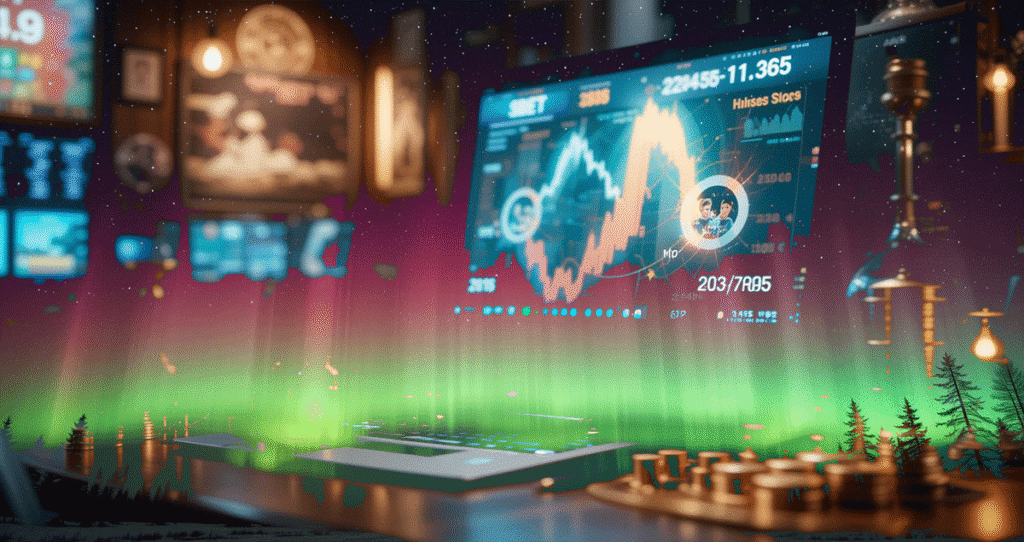
- Solar wind speed and density variations
- Magnetic field strength and orientation changes
- Particle flux measurements
- Temperature fluctuations in solar plasma
Geomagnetic Field Interactions
When the magnetosphere is hit by solar particles, various interactions decide how active the auroras will be. Modern NOAA aurora forecast systems use sophisticated mathematical models to predict these interactions with remarkable precision. The process involves:
- Magnetic Reconnection Events: Solar wind magnetic fields connecting with Earth’s field
- Particle Acceleration: Charged particles speeding toward polar regions
- Atmospheric Collisions: High-energy particles excite atmospheric gases
- Light Emission: Excited atoms release photons as colorful aurora displays
Machine Learning Integration
Advanced aurora borealis tracker technology now incorporates artificial intelligence that continuously learns from historical patterns. These systems analyze millions of data points to identify subtle precursor conditions that human observers might miss. Machine learning algorithms excel at:
| AI Capability | Function | Accuracy Improvement |
| Pattern Recognition | Identifying solar wind signatures | 35% better than traditional methods |
| Probability Calculation | Risk assessment for aurora events | 42% more accurate predictions |
| Regional Adaptation | Local condition optimization | 28% improved location-specific forecasts |
| Real-time Processing | Instant data analysis | 50% faster alert generation |
Magnetosphere Modeling
Scientists use complex three-dimensional models to simulate how Earth’s magnetic field responds to varying solar wind conditions. These simulations predict aurora oval position, intensity levels, and geographic coverage with unprecedented detail. The models account for seasonal variations, magnetic declination differences, and atmospheric density changes that affect aurora visibility from different locations.
NOAA Space Weather Prediction Center: The Gold Standard of Aurora Forecasting
Comprehensive Monitoring Infrastructure
The National Oceanic and Atmospheric Administration operates the world’s most extensive space weather monitoring network, providing the foundation for reliable aurora borealis forecasts noaa services. Their infrastructure includes ground-based magnetometers, solar observatories, and satellite systems that work together around the clock.

NOAA’s monitoring capabilities encompass global magnetometer networks that detect magnetic field fluctuations in real-time. These sensitive instruments can identify the subtle changes that precede major geomagnetic events, often providing several hours of warning before aurora activity intensifies. The network includes stations across:
- Arctic regions for high-latitude monitoring
- Mid-latitude locations for storm detection
- Equatorial stations for global magnetic field tracking
- Ocean-based platforms for comprehensive coverage
OVATION Model Excellence
The NOAA Ovation model represents the pinnacle of aurora prediction technology, providing detailed aurora oval forecast information that shows exactly where northern lights will appear. This revolutionary system processes multiple data streams to generate real-time aurora borealis visibility map displays that update every 30 minutes.
The software uses algorithms to assess the likelihood of an aurora by studying what is currently happening in the solar wind, historical data, and the behavior of the Earth’s magnetic field. The system provides:
- Geographic Coverage Maps: Precise aurora boundary predictions
- Intensity Forecasts: Expected brightness levels for different regions
- Timing Estimates: Peak activity windows for optimal viewing
- Confidence Intervals: Statistical reliability measures for each prediction
Professional Forecasting Services
The agency’s expert space forecasters blend machine modeling with personal experience to describe and explain difficult space weather activities. People in this field watch the sun all day, every day, and alert others to approaching major solar flares or unusual geomagnetic storms.
The NOAA Space Weather Prediction Center Aurora Forecast Services include detailed technical discussions that help advanced users understand the reasoning behind specific predictions. Professional forecasters provide context about solar cycle trends, seasonal variations, and regional factors that influence aurora visibility.
Data Integration and Accessibility
Aurora forecast systems developed by NOAA consider data received from many satellites, like the Advanced Composition Explorer (ACE), Deep Space Climate Observatory (DSCOVR), and the different GOES (Geostationary Operational Environmental Satellites). Using multiple sources helps guarantee stability, no matter what happens on any one satellite.
The approach also includes observatories on the ground, wide-view cameras, and networks of citizens, who help make sure the forecasts are accurate in real time. Because NOAA takes this approach, its predictions for auroras are respected everywhere.
Special Apps for Watching Auroras Use Both Modern Devices and Space Science
Revolutionary Mobile Platforms
Thanks to applications on our smartphones, now, many people around the world can watch for auroras as a hobby, not just as a field of expertise. Using My Aurora Forecast, users quickly get highly detailed aurora alerts and updates about the northern lights on their smartphones.
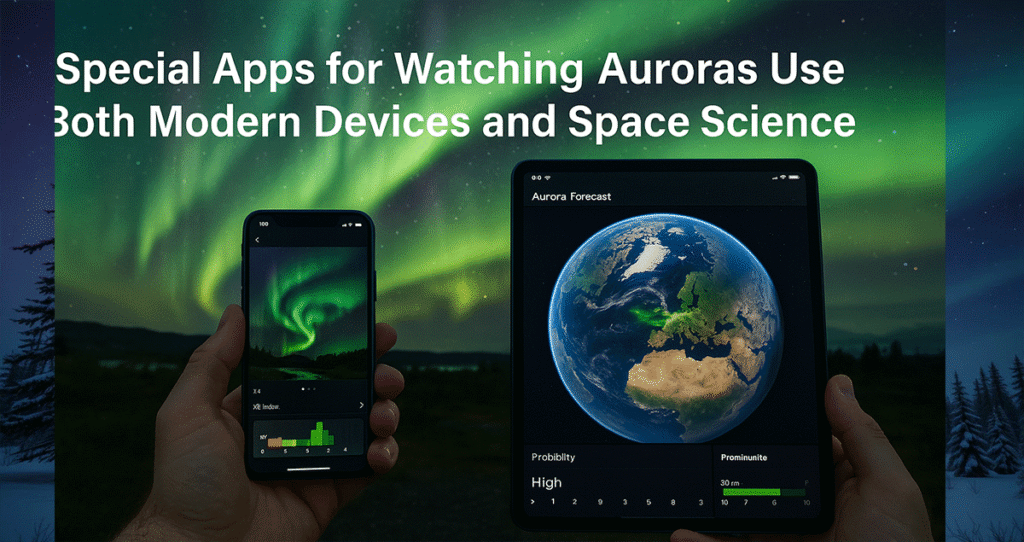
These applications integrate multiple data sources to provide comprehensive aurora viewing forecast information tailored to individual preferences. Users can configure alerts based on:
- Activity Threshold Levels: Minimum KP index for notifications
- Geographic Boundaries: Specific viewing radius from the user location
- Time Restrictions: Preferred alert hours for viewing attempts
- Weather Integration: Cloud cover considerations for realistic viewing probability
Advanced Feature Sets
Contemporary aurora tracker applications go far beyond simple notification systems to include educational content, interactive visualizations, and community features that enhance the overall aurora watching experience. Premium applications typically offer:
- Real-time Aurora Maps: Interactive displays showing current activity levels
- Photography Planning Tools: Optimal timing for aurora photography
- Historical Data Access: Past activity patterns for location analysis
- Sharing Features: Community-driven aurora reporting systems
Cloud Cover Integration
One of the most significant advances in mobile aurora forecasting involves combining space weather predictions with terrestrial weather data. Aurora borealis weather forecast integration addresses the common frustration of favorable geomagnetic conditions obscured by cloud cover.
Advanced applications now provide comprehensive viewing probability assessments that consider:
| Weather Factor | Impact on Viewing | Application Response |
| Cloud Coverage | High impact – blocks aurora visibility | Integrated meteorological forecasts |
| Atmospheric Transparency | Moderate impact – affects brightness | Seeing condition assessments |
| Light Pollution | Variable impact – depends on the aurora intensity | Dark sky location recommendations |
| Moon Phase | Low impact – affects contrast | Optimal viewing time calculations |
User Experience Optimization
Modern aurora tracking applications prioritize user experience through intuitive interfaces, smart notification systems, and personalized content delivery. These platforms learn from user behavior to optimize alert timing, reduce false notifications, and provide increasingly relevant information.
The most successful applications balance comprehensive technical information with accessible presentation, making complex space weather data understandable for users with varying levels of scientific background. This approach has democratized aurora forecasting, making professional-quality predictions available to anyone with a smartphone.
Regional Specialization: Tailored Forecasting for Global Aurora Viewing
North American Coverage Excellence
Regional specialization has become essential as aurora viewing popularity has expanded globally, with services like Aurora Forecast Montana providing predictions optimized for specific geographic areas. These specialized platforms account for local magnetic declination, typical weather patterns, elevation effects, and regional viewing conditions that significantly influence aurora visibility.
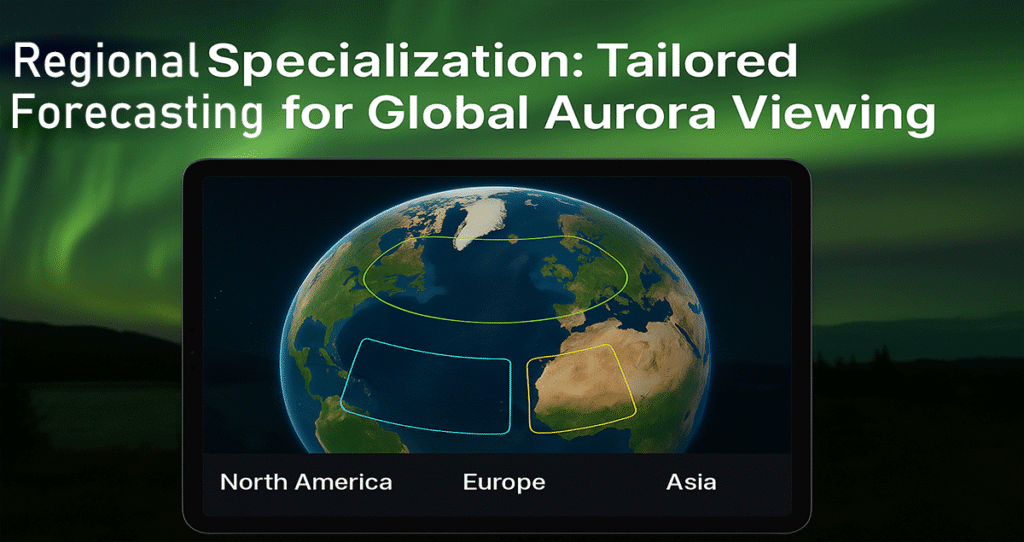
North American services excel at addressing the unique challenges faced by viewers across different latitudes and longitudes. The continent’s vast geographic diversity requires sophisticated modeling that accounts for:
- Magnetic Declination Variations: How local magnetic field angles affect aurora appearance
- Elevation Considerations: Mountain regions offering clearer viewing conditions
- Urban Light Pollution: City-specific recommendations for optimal viewing locations
- Climate Patterns: Regional weather trends affecting viewing probability
European Excellence in Aurora Prediction
European aurora forecast services have evolved to serve the continent’s diverse aurora viewing opportunities, from Scotland’s northern regions to Scandinavia’s prime viewing locations. The Nordic Lights forecast systems incorporate data from European Space Agency satellites and regional magnetometer networks to provide highly accurate predictions.
European services understand the continent’s unique viewing challenges, including relatively southern latitudes for many locations and the influence of North Atlantic weather systems. Specialized regional services include:
- Scandinavian Specialists: Services covering Norway, Sweden, and Finland
- Scottish Highlands Coverage: Predictions for northern Scotland viewing areas
- Iceland Tourism Services: Dedicated forecasts for aurora tourism hotspots
- Baltic Region Monitoring: Coverage for northern European viewing opportunities
Arctic and Sub-Arctic Specialization
The growing aurora tourism industry has driven the development of highly specialized forecasting services for premier viewing destinations. Services like the VIK Aurora forecast provide detailed predictions specifically for Iceland, while the Ruka Aurora forecast serves visitors to Finnish Lapland.
These location-specific services combine general geomagnetic predictions with local expertise about optimal viewing conditions, seasonal patterns, and tourism logistics. They typically offer:
- Tourism Integration: Coordination with local tour operators and accommodations
- Cultural Context: Information about local aurora legends and folklore
- Logistics Support: Transportation and equipment recommendations
- Safety Guidance: Cold weather and remote location safety information
Precision Location Services
The development of aurora borealis forecast by zip code represents the ultimate in location-specific prediction technology. These services account for micro-regional factors that can significantly influence viewing success, including local topography, typical cloud patterns, and light pollution characteristics.
Precision location services utilize advanced geographic information systems (GIS) to provide recommendations that consider factors invisible to broader regional forecasts. This level of detail helps users make informed decisions about whether to travel to remote viewing locations or attempt viewing from their immediate area.
Advanced Prediction Algorithms: The Technology Behind Accurate Aurora Forecasting
Computational Model Sophistication
The remarkable accuracy of contemporary aurora prediction stems from advanced computational models that process enormous datasets in real-time to generate forecasts across multiple time scales. These aurora borealis prediction algorithms incorporate machine learning techniques that continuously refine their accuracy by analyzing relationships between solar wind parameters and observed aurora activity.
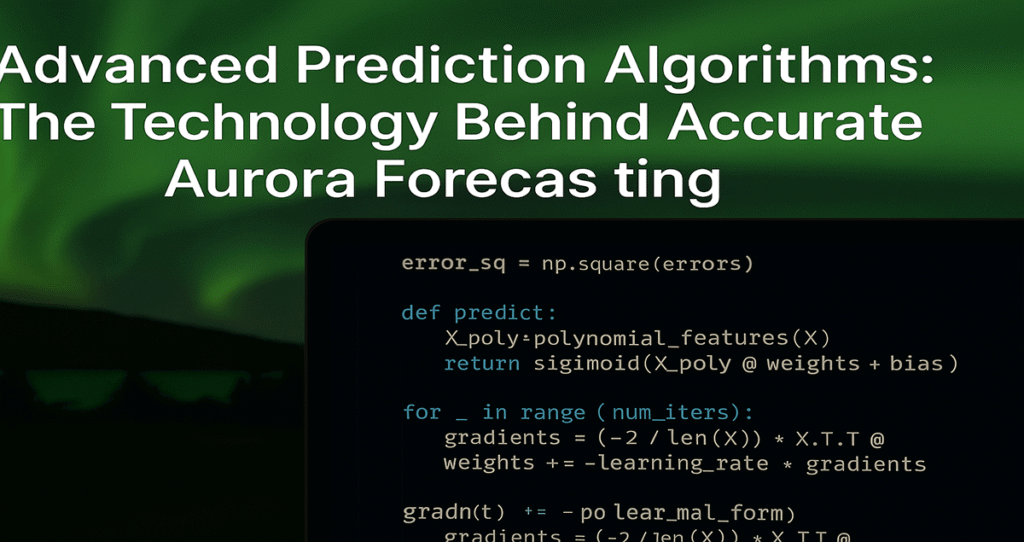
Modern prediction systems utilize ensemble modeling approaches that run multiple prediction scenarios simultaneously, providing uncertainty estimates alongside primary forecasts. This probabilistic approach helps users understand confidence levels and make informed decisions about viewing plans.
Multi-Parameter Analysis Systems
Real-time aurora forecast systems monitor dozens of variables simultaneously to identify the complex combinations of conditions that produce significant aurora events. These parameters include:
| Parameter Category | Specific Measurements | Prediction Impact |
| Solar Wind Properties | Speed, density, temperature | Primary activity drivers |
| Magnetic Field Data | Strength, orientation, variability | Aurora intensity predictors |
| Geomagnetic Indices | KP, AE, Dst measurements | Regional activity indicators |
| Atmospheric Conditions | Density, composition, temperature | Visibility and color factors |
Pattern Recognition Technology
Advanced algorithms excel at identifying subtle patterns in solar wind data that precede significant geomagnetic events. These systems can recognize rare condition combinations that might escape human analysis, providing valuable early warning for exceptional display opportunities.
The technology continuously learns from new data, improving prediction accuracy through experience. Historical pattern analysis helps identify seasonal trends, solar cycle influences, and unusual condition combinations that produce memorable aurora displays.
Probabilistic Forecasting Methods
Contemporary aurora lights prediction models provide probability estimates rather than simple yes/no predictions, acknowledging the inherent uncertainties in natural phenomenon forecasting. This approach gives users realistic expectations and helps with decision-making about travel, equipment preparation, and viewing strategies.
Probability calculations consider multiple factors simultaneously, including geomagnetic activity likelihood, weather condition prospects, and historical success rates for specific locations and seasons. This comprehensive approach provides users with the information needed for informed planning decisions.
Time-Scale Variations: From Minutes to Months in Aurora Prediction
Immediate Response Forecasting
The most dynamic aspect of modern aurora forecasting involves aurora 30-minute forecast systems that capture rapidly changing geomagnetic conditions. These high-frequency updates are essential during active periods when solar wind parameters fluctuate significantly, potentially creating sudden opportunities for exceptional viewing.
Immediate response systems monitor solar wind arrival times, magnetic field rotations, and substorm development to provide minute-by-minute updates during active periods. Professional aurora photographers and researchers rely on these rapid updates to optimize their observation timing.
Short-Term Precision Forecasting
Aurora forecast hourly predictions focus on the detailed evolution of geomagnetic conditions throughout individual viewing sessions. These forecasts are particularly valuable for aurora photography, where optimal conditions might last only brief periods during longer viewing windows.
Short-term forecasting excels at predicting:
- Peak Activity Timing: When aurora displays reach maximum intensity
- Geographic Extent: How far south will Aurora visibility extend
- Duration Estimates: How long will favorable conditions persist
- Intensity Variations: Expected brightness changes throughout the night
Medium-Term Planning Horizons
Services providing 3 day aurora forecast and 7-day aurora forecast information balance detail with practical planning requirements for most users. These forecasts incorporate longer-term solar wind stream patterns while maintaining sufficient precision for travel planning and equipment preparation.
Medium-term predictions are invaluable for aurora tourism, allowing visitors to optimize their travel timing and activity scheduling. Tour operators rely on these forecasts to adjust itineraries and manage customer expectations effectively.
Extended Outlook Services
Aurora forecast 10 days and aurora forecast 14 days services extend planning capabilities while acknowledging increased uncertainty inherent in longer-term predictions. These forecasts focus on identifying favorable periods within longer time windows rather than specific daily conditions.
Extended forecasting proves particularly valuable for:
- International Travel Planning: Optimizing multi-week aurora viewing trips
- Equipment Preparation: Planning for specialized photography gear
- Research Expedition Scheduling: Academic and scientific observation planning
- Tourism Industry Operations: Seasonal planning for aurora-related businesses
Understanding Aurora Visibility and Probability Calculations
Comprehensive Visibility Assessment
Aurora visibility extends far beyond simple geomagnetic activity measurements to encompass atmospheric conditions, geographic factors, and seasonal considerations that determine actual viewing success. Modern aurora borealis visibility systems integrate these multiple factors to provide realistic viewing probability estimates.
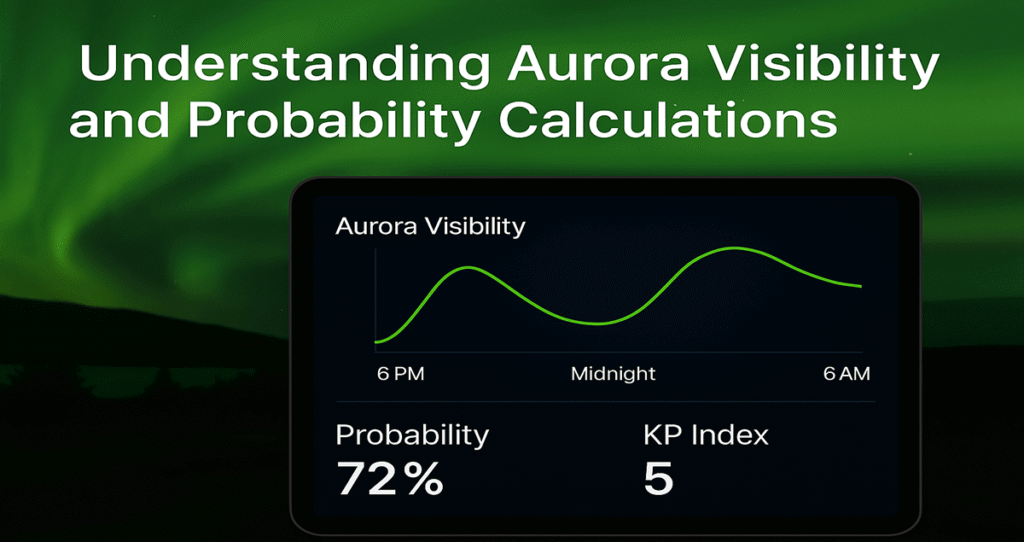
Visibility calculations must account for the complex relationship between geomagnetic activity levels and aurora oval expansion. Higher activity levels push aurora displays toward lower latitudes, making northern lights visible from locations that might not typically experience such displays.
Multi-Factor Probability Models
Contemporary aurora viewing probability calculations incorporate sophisticated models that consider meteorological and astronomical factors alongside space weather conditions. These comprehensive assessments address common viewing challenges:
| Factor Category | Specific Considerations | Probability Impact |
| Atmospheric Conditions | Cloud cover, transparency, humidity | High – can completely prevent viewing |
| Geographic Location | Latitude, magnetic declination, elevation | High – determines baseline viewing potential |
| Light Pollution | Urban glow, artificial lighting | Moderate – affects the visibility of weaker displays |
| Lunar Conditions | Moon phase, position, and brightness | Low – influences contrast and photography |
Regional Adaptation Algorithms
Aurora chance tonight calculations now incorporate location-specific historical data that accounts for regional climate patterns, typical cloud cover frequencies, and seasonal viewing success rates. This localization makes predictions more relevant and accurate for specific geographic areas.
Advanced systems maintain databases of viewing success rates for thousands of locations, allowing them to provide context about how current predictions compare to historical patterns. This information helps users set realistic expectations and make informed decisions about viewing attempts.
Tourism and Planning Integration
The integration of aurora probability calculations with tourism planning has created new opportunities for aurora-focused travel. Services now provide comprehensive assessments that consider travel logistics, accommodation availability, and alternative activities during unfavorable viewing conditions.
These integrated services help tourists optimize their aurora viewing investments by providing realistic probability assessments alongside practical planning information about destinations, timing, and backup activities.
Real-Time Monitoring and Alert Systems: Staying Connected to Aurora Activity
Intelligent Notification Systems
Contemporary aurora alert real-time platforms have evolved from simple threshold-based notifications to sophisticated systems that learn user preferences and optimize alert timing for maximum relevance. These platforms reduce notification fatigue while ensuring users receive timely alerts about genuine viewing opportunities.

Modern notification systems incorporate user feedback mechanisms that help refine alert criteria over time. Users can report viewing success rates, preferred notification timing, and false alarm frequency to help the system optimize future alerts.
Community-Driven Verification
The integration of social media and community reporting features creates valuable feedback loops that enhance prediction accuracy and provide ground-truth verification. Users contribute real-time observation reports, photographs, and local condition updates that benefit the entire aurora watching community.
Community verification systems help identify regional variations in viewing conditions, unusual display characteristics, and equipment performance under different environmental conditions. This crowd-sourced information improves forecast accuracy and provides valuable context for other users.
Multi-Platform Integration
Live aurora tracker systems now integrate across multiple devices and platforms, ensuring users maintain connectivity with aurora conditions regardless of their location or device preferences. Cloud-based synchronization keeps alert preferences and viewing history consistent across smartphones, tablets, and computers.
Integration extends to smart home systems, vehicle navigation units, and wearable devices, creating comprehensive notification ecosystems that adapt to users’ lifestyles and preferences.
Professional Monitoring Capabilities
Advanced users and professional researchers can access enhanced monitoring capabilities that provide detailed technical information about geomagnetic conditions, solar wind parameters, and prediction confidence levels. These professional features support scientific research, photography planning, and commercial aurora-related activities.
Professional monitoring includes:
- Detailed Parameter Displays: Comprehensive space weather measurements
- Historical Data Access: Extended databases for pattern analysis
- Export Capabilities: Data download for offline analysis
- Custom Alert Configuration: Sophisticated threshold and timing controls
Seasonal Patterns and Solar Cycle Influences: Long-Term Aurora Forecasting
Solar Cycle Integration
Understanding solar cycle influences has enabled sophisticated long-term forecasting that helps users optimize aurora viewing strategies across multiple years. During the current period of increased sun activity, auroras are more frequent and can be stronger, which makes predicting them both more important and more valuable.
There are many chances to see northern lights in 2025, since solar cycle 25 is causing extra solar flares and coronal mass ejections that lead to regular geomagnetic storms. This increased activity expands aurora visibility toward populated areas that rarely experience northern lights during quieter solar periods.
Seasonal Optimization Strategies
Seasonal variations in aurora viewing extend beyond daylight considerations to include complex interactions between Earth’s orbital position, magnetic field orientation, and atmospheric density changes. Professional forecasters use all these elements to choose the best times to watch the aurora.
- Equinoctial Enhancement: Spring and autumn periods show increased geomagnetic activity
- Winter Advantage: Longer darkness periods in northern regions
- Summer Challenges: Continuous daylight limits viewing in extreme northern locations
- Transition Periods: Seasonal changes create unique viewing opportunities
Climate Pattern Integration
Long-term aurora forecasting now incorporates climate pattern analysis that helps predict seasonal weather trends affecting viewing conditions. El Niño and La Niña cycles, Arctic oscillation patterns, and regional climate trends influence cloud cover patterns and viewing success rates.
This climate integration helps users plan extended aurora viewing trips by identifying seasons with historically favorable combinations of aurora activity and clear weather conditions.
Historical Pattern Analysis
Advanced forecasting systems maintain extensive databases of historical aurora activity that help identify long-term patterns and cycles beyond the primary solar cycle. These patterns include:
| Pattern Type | Duration | Forecasting Value |
| Solar Cycle Phases | 11 years | Primary activity trends |
| Seasonal Variations | Annual | Optimal viewing periods |
| Magnetic Field Cycles | 22 years | Long-term activity patterns |
| Climate Correlations | Variable | Weather condition trends |
Integration with Weather Forecasting: Comprehensive Viewing Condition Assessment
Holistic Condition Assessment
The most sophisticated aurora forecasting platforms integrate comprehensive meteorological data with geomagnetic predictions to provide realistic viewing condition assessments. It helps to address the concern of when mild space weather coincides with poor conditions on Earth.
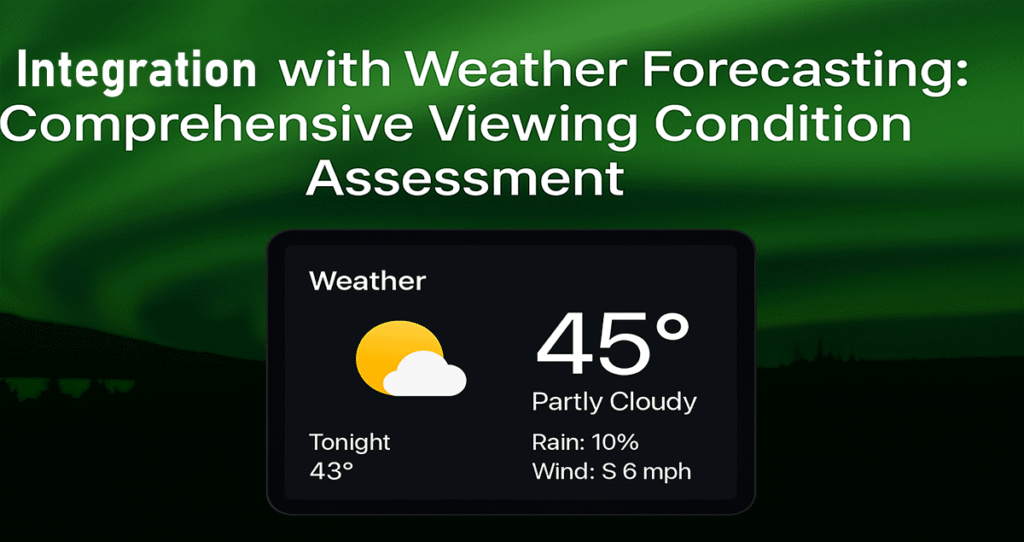
Modern aurora borealis weather forecast systems recognize that successful aurora viewing depends equally on space weather conditions and local atmospheric conditions. This holistic approach provides users with actionable information about their actual viewing prospects.
Advanced Meteorological Integration
Cloud cover analysis represents the most critical aspect of weather integration, as different cloud types have varying impacts on aurora visibility. Advanced systems provide detailed assessments of:
- Cloud Type Classification: Distinguishing between thin high clouds and thick low clouds
- Coverage Percentage: Quantifying cloud coverage across viewing areas
- Temporal Evolution: Predicting cloud movement and dissipation patterns
- Regional Variations: Accounting for local topographic influences on weather
Atmospheric Seeing Conditions
Professional-grade forecasting systems incorporate atmospheric seeing assessments similar to those used in astronomical observations. These assessments consider atmospheric turbulence, temperature gradients, and humidity levels that affect aurora display quality and photography opportunities.
Seeing condition forecasts prove particularly valuable for aurora photographers who need optimal atmospheric stability for sharp, detailed images. These conditions also affect visual observation quality for serious enthusiasts seeking the best possible viewing experiences.
Multi-Location Weather Analysis
Advanced weather integration extends beyond single-point forecasts to include regional weather pattern analysis that helps users identify alternative viewing locations when local conditions are unfavorable. This capability is particularly valuable for aurora tourists with flexibility in their viewing location choices.
Regional analysis considers topographic influences, local climate patterns, and historical weather trends to recommend optimal viewing locations within reasonable travel distances from users’ base locations.
Future Developments and Emerging Technologies in Aurora Forecasting
Next-Generation Satellite Networks
Satellites made for space weather surveillance have the potential to greatly improve how auroras are predicted by monitoring conditions over a wide area and a brief time. These advanced systems will provide a three-dimensional understanding of solar wind structure that significantly improves prediction precision.

Future satellite networks will include:
- Distributed Solar Wind Monitoring: Multiple measurement points for better spatial coverage
- Enhanced Temporal Resolution: More frequent data updates for rapid condition changes
- Advanced Sensor Technology: Improved measurement accuracy and reliability
- Automated Data Processing: Real-time analysis and alert generation capabilities
Artificial Intelligence Advancement
Machine learning applications in aurora forecasting continue expanding beyond pattern recognition to include complex multi-parameter optimization and predictive modeling. These advanced systems will identify subtle condition combinations and provide extended forecast horizons while maintaining high accuracy levels.
AI development areas include:
• Deep Learning Models: Enhanced pattern recognition capabilities • Predictive Analytics: Extended forecast horizons with maintained accuracy • Anomaly Detection: Identification of unusual conditions and rare events • Personalization Algorithms: User-specific optimization and recommendation systems
Citizen Science Integration
The expansion of citizen science networks through mobile applications and automated observation systems creates opportunities for real-time model validation and improvement. Community-based monitoring supplements professional networks and provides valuable ground-truth data across diverse geographic regions.
Citizen science contributions include real-time observation reports, automated photography systems, and crowdsourced weather condition updates that enhance forecast accuracy and provide valuable verification data.
Augmented Reality Applications
Emerging augmented reality applications promise to transform aurora viewing experiences by overlaying prediction information directly onto real-world views. These systems will provide real-time guidance about optimal viewing directions, expected activity levels, and photography opportunities.
AR applications will integrate multiple data sources to provide comprehensive viewing guidance that considers current conditions, user location, and equipment capabilities to optimize individual viewing experiences.
Conclusion: Embracing the Golden Age of Aurora Forecasting
Because of the combination of space weather science, better modeling, and helpful technology, aurora forecasting is now much better and has greatly changed the way people experience seeing northern lights. Current forecasting methods give the public accurate and easy access to information about when the aurora will be visible.
The variety of forecasting tools in 2025 supports both general users who want a quick tonight forecast and those professional users who prefer in-depth analysis and planning for their work. Because of this easy access to professional information, aurora tourism has expanded, scientists now have more resources for their studies, and everyone gets a better understanding of space weather.
The latest solar cycle, along with advanced ways to forecast the weather, opens up many chances for watching the Northern Lights. When users can see the auroras as they happen, get quick alerts, and have all the information, they can watch them unexpectedly or make sure they are in the right place to see them at their best.
The advent of new technology will improve aurora forecasts, allowing more access to such information for everyone. With the help of advanced technology, many more opportunities to see the northern lights have appeared for aurora watchers in 2025.
